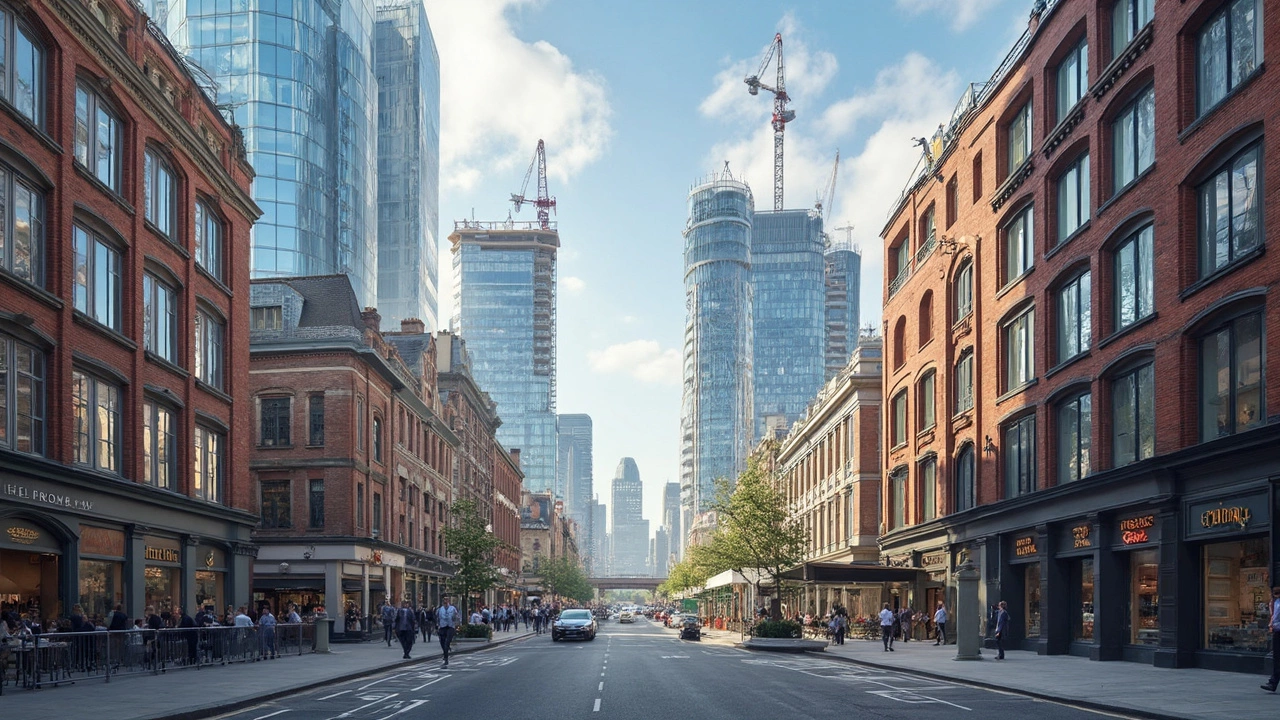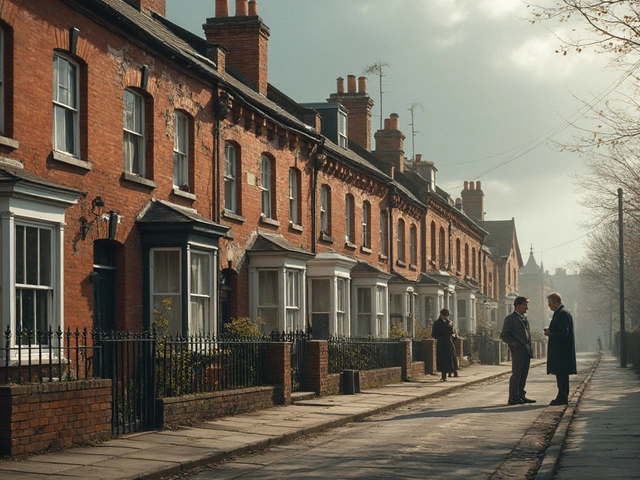The word 'commercial' gets thrown around a lot in construction, but what does it really mean? If you’re thinking it just means an office block or a big shop, there’s more to it. A commercial project is basically any building where business happens—shops, cafés, hotels, warehouses, even your local gym. If money is changing hands, and it isn’t someone’s home, you’re looking at commercial space.
This isn’t just about size either. Yes, commercial buildings often look bigger or flashier, but it’s more about how they’re used and the strict rules they follow. From the way the plumbing works, to fire exits and disabled access—everything’s laid out by law, not just for looks. Builders, owners, and even tenants have to play by these commercial rules or risk a mountain of trouble later.
Getting the basics right at the start saves cash and a load of headaches. Know what ‘commercial’ means in construction, and you’ll spot problems way before they blow up into something big. Whether you run a family café or oversee a whole shopping park, these rules shape your costs, your day-to-day life, even your insurance premiums. That’s why it pays to get clued up early.
- What Makes a Building Commercial?
- Key Differences From Residential Construction
- Common Challenges in Commercial Projects
- Practical Tips for Owners and Tenants
What Makes a Building Commercial?
It comes down to use and intent. A commercial building is any space built for people to do business that isn’t just about living. Offices, supermarkets, car dealerships—if the main job of the building is to generate money through products or services, it falls in this category. It can even include apartment blocks where units are rented out, since that’s a business transaction, not just a place to live.
In the UK, commercial properties are defined by planning law and tax codes. For example, Bristol City Council's planning portal says that commercial use covers shops, food outlets, offices, leisure facilities, warehouses, and anything not used as a private home. When you get involved in a commercial construction project, you’re stepping into a world with its own set of rules — things like stricter safety laws, detailed accessibility standards, and very specific environmental regulations.
This stuff isn’t just paperwork. For a business, failing to follow these standards can mean steep fines or even having to shut down. The Royal Institution of Chartered Surveyors (RICS) sums it up well:
“Commercial buildings are purpose-built to accommodate business activities, and as a result, are subject to regulations far more demanding than their residential counterparts.”
Here's a quick look at what typically makes a building ‘commercial’:
- Purpose: Used primarily for business or income-generating activity.
- Legal Status: Registered as commercial in planning and land use documents.
- Design Features: Includes safety systems, more robust electrical and HVAC needs, lifts, wide corridors, and usually more than one exit.
- Accessibility: Must allow access for disabled individuals under UK law, with features like ramps and accessible toilets.
- Higher Traffic: Designed to cope with more visitors or employees moving through each day.
Take Bristol’s city centre—nearly one-third of properties are classed as commercial. Local business rates are set higher for these buildings, and most have extra insurance requirements compared to homes.
If you’re thinking of building, buying, or renting a business property, double-check its classification early. That’s what separates a hassle-free launch from getting tangled in red tape.
Key Differences From Residential Construction
People often lump all building work together, but commercial construction is a totally different game from building houses. If you’ve ever wondered why shops and offices look and feel different from your home, there’s a reason for that—lots of them, actually.
First up, the rules. Any commercial building gets hit with strict codes and regulations. Fire safety? Tougher checks. Accessibility? You’ll need ramps, lifts, wider hallways. Wiring, plumbing, heating—all built to handle more people and bigger demands than in a regular house. If you skip on these, you won’t even get a building sign-off.
Another big difference is the materials and scale. Houses use timber a lot, but a shopping centre or office park? You’re looking at steel, reinforced concrete, or strong glass. Basically, stuff designed to last longer under heavy use. A café or gym will see more people in a day than a standard house sees all month, so everything needs to be built bulkier and be easy to repair or upgrade.
Time is a whole other story. Commercial construction projects often run on tight deadlines. Every extra week means lost rent and business. Owners and developers push for speed, but the flipside is the sheer amount of planning, permits, and paperwork. There are regular inspections, and sometimes whole teams just to handle project management.
- Zoning: Commercial zones are often separated from residential areas. You can’t just turn a house into a corner shop without planning approval.
- Costs: While homes aren’t cheap, commercial projects eat up bigger budgets thanks to engineering, safety systems, and higher-quality finishes.
- Future-proofing: Shops and offices need flexible layouts—think moving walls, big open spaces—for new tenants down the line. Homes usually stick to a fixed layout.
One interesting fact: Under UK law, fire alarm systems in commercial buildings must meet BS 5839 standards—it’s not enough to just pop a few battery alarms on the ceiling, as you might at home.
| Aspect | Residential | Commercial |
|---|---|---|
| Fire Safety | Basic alarms, simple exits | Full systems, multiple exits, sprinkler systems |
| Accessibility | Stairs, basic ramps if needed | Lifts, wheelchair toilets, wider doors |
| Use of Space | Fixed rooms | Flexible layouts |
| Materials | Wood, standard insulation | Steel, reinforced concrete |
So, when someone talks about commercial construction, remember: it’s not just a bigger box. It’s a whole set of rules, plans, and expectations built for businesses, not bedrooms.

Common Challenges in Commercial Projects
Tackling commercial construction isn’t like building a house. You’ve got bigger budgets, serious safety standards, and a whole crowd of people to keep happy—from investors to future shops and offices. Unsurprisingly, the headaches can be bigger too.
The first big stumbling block for most projects? Planning. You need planning approval for nearly everything in commercial building. Councils in the UK are strict, and it’s not just about getting the height or look right—they’ll check traffic, fire safety, and even impact on local wildlife. If you miss one small detail in your paperwork, you could add months (and a load of costs) to the build.
Then there’s money. Cash flow crunches hit hard, especially if materials suddenly spike in price—just look at how steel and timber prices bounced around in 2023, with some materials doubling in cost. Owners and developers often have to juggle between getting quality and keeping to a realistic budget. One missed order, or underestimating something small, and you might see your profit drain away.
Weather is another pain in the neck. Here in Bristol, rain can stop work for days. Lost time means paying out for people and plant hire while nothing gets done. That’s why a lot of sites now use digital scheduling tools to dodge the worst delays.
Keeping up with rules is a full-time job too. Every commercial property must follow Building Regulations, health and safety rules, and energy efficiency standards. Ever heard of BREEAM? It’s a system used in the UK to rate how green a building is, and these targets can be tough to meet—especially if you’re converting an old warehouse rather than starting fresh.
Probably the most stressful part? Coordinating dozens of contractors and workers without them tripping over each other. One delay from a supplier, or one missed email, and suddenly, the whole build goes sideways. Good project managers stay on the ball with weekly check-ins and fast decisions.
| Common Issue | Impact |
|---|---|
| Planning Delays | Project timelines stretch, higher costs |
| Supply Chain Problems | Costs rise, work stops |
| Poor Weather | Site closures, extra labour needed |
| Strict Regulations | Rework, extra design costs |
| Contractor Scheduling | Miscommunication, slowdowns |
If you’re starting out in commercial construction, keep a close eye on timelines, approval paperwork, and supply orders. The small stuff adds up fast—and one little hiccup can snowball if you’re not ready.
Practical Tips for Owners and Tenants
If you own or rent a commercial building, missing the small stuff can empty your wallet fast. Here’s what actually matters day-to-day.
- Stay on top of inspections: Rules for commercial construction are strict. Fire doors, alarms, lifts, plumbing—everything needs checking regularly. Local councils can swoop in for surprise checks. Keep a record of all maintenance and safety certificates. Don’t trust memory—write it down, keep digital copies.
- Know your lease: Commercial leases are a different beast. They’ll spell out who’s on the hook for repairs, insurance, and even cleaning the gutters outside. Before you sign, check if you’re suddenly responsible for fixing that old roof. Don’t just glance—read every line or get someone who will.
- Plan for accessibility: UK law makes it clear: your business space has to be accessible for everyone. That means ramps, lifts, and accessible toilets. If you’re doing up a space, budget for these upgrades upfront. Skip this and you could face complaints or fines, and you’ll lose good customers.
- Get proper insurance: Insurance for commercial building use is a world away from your home policy. It should cover everything—liability, business interruption, injuries onsite, and damage from hackers if you store customer data. Every year, review your cover because the risks change.
Here’s a hard fact: according to the British Council for Offices, over 40% of business property claims come from water leaks and bad plumbing. That’s not glamorous, but keeping pipes and drains in check can save thousands.
| Issue | Average Repair Cost (£) |
|---|---|
| Water Leaks | 2,700 |
| Faulty Electrics | 1,800 |
| Fire Alarm Upgrades | 1,200 |
Construction rules in the commercial world can change fast, especially with green standards and tech updates. Subscribe to local council newsletters. Even joining an online group for business property landlords helps—you’ll hear about changes before they hit the news.





